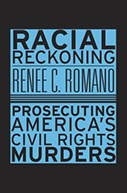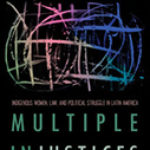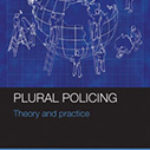Racial Reckoning: Prosecuting America’s Civil Rights Murders

Author: Renee C. Romano
Publisher: Cambridge, MA: Harvard University Press, 2014. 280p.
Reviewer: Angela Mae Kupenda | January 2015
Racial Reckoning: Prosecuting America’s Civil Rights Murders is an exceptional work by Renee C. Romano. This review will first discuss a concern I had prior to reading her book. Discussion of this alleviated concern will be followed by brief consideration of Romano’s well selected titled, which will be followed by a discussion of what I see as major contributions of the book.
I will start with my confession. When I was invited to read this book and write a review I had some concerns. I feared that Romano’s book would have as its chief thesis that the prosecutions of civil rights murderers were only a weak tradeoff for complete justice and, therefore, served no purpose. My concerns came from my own lived history in America and my respect for each civil rights battle. I was born in Mississippi in the late 1950’s, grew up in the de jure segregated Deep South and did not attend an integrated class until the early 1970s. The university I later attended had been the site of White police opening fire and killing several Black students as a campus protest was disbanding. Many readers here have no doubt heard about the May 4, 1970, police shootings at Kent State University in Ohio, which led to a United States Supreme Court ruling and a financial settlement for the bereaved White families. Likely, though, few readers have heard of the May 15, 1970, police shootings at Jackson State University in Mississippi, which resulted in neither convictions for the defendants nor financial recoveries for the bereaved Black families.
Some say this was all so long ago. Yes, slavery, state sanctioned Jim Crow, de jure segregation, these 1970 killings of students, and other killings documented in Romano’s book occurred many years ago. Still, I do not believe we are post-racial anywhere in America, even with the election of a Black president and given the racially motivated opposition he and even his family experience. Evidently, just with a cursory read of the headlines, we still have much racial reckoning to do in America, especially in law enforcement/community relations. Yet, often one step toward justice comes only after a long-term struggle. Admittedly, an eventual prosecution and conviction, for example of Byron De La Beckwith in 1994 for the 1963 murder of Medgar Evers, do not reckon all of the racial inequalities suffered in America. Still, the long-time-coming prosecutions and convictions of America’s civil rights murderers must be celebrated for the amount of racial reckoning achieved; and, they must be further utilized to embolden a faster pace toward equity.
Hence, before reading her book, I was concerned as to whether Romano’s work would downplay the much longed for, and fought for, prosecutions. After a careful reading of Romano’s book, I found my concerns essentially unwarranted. To the contrary, one of her major points is that, while the reopening of cases, prosecutions, and convictions gave some relief to families and communities seeking fuller justice in America, the trials were only a step toward racial reckoning. Romano argues that, while the prosecutions served a significant purpose, much more is needed to complete the racial reckoning of America’s civil rights murders. With this, I enthusiastically agree.
Before I consider three major contributions of her work, Romano’s title deserves comment. Every word in the title of her book has meaning, even the word “America’s.” As Romano clearly documents, the murders of the civil rights workers and others just seeking constitutionally promised freedom were not committed by an isolated few, deranged, racist people. Rather, the murders occurred as a part of structural racial subjugation in a system bent on enforcing White supremacy forever. Yes, the individuals who pulled the ropes committing murder by lynching, who hid in bushes and pulled the triggers shooting men in the back, who drowned young people in lakes, and who waited on deserted highways to kill, were murderers. Those individual murderers though were “not just a few knuckleheads” acting in isolation, however. The local, state, and federal governmental authorities who aided or tolerated the killings were also complicit. In addition, the many American citizens who supported White supremacy, or turned their backs on innocents, were also complicit. Therefore, Romano is right to refer to the murders as “America’s civil rights murders,” and a full racial reckoning requires steps in addition to the prosecution of those who more obviously committed the final killing acts. Romano explores all of the levels of America’s participation in “America’s civil rights murders” in her straightforward, well documented, powerful and provocative book.
There are so many great things to say about her book. I will focus here on three major contributions. First, Romano provides a useful account, in the introduction and in chapters 1-2 of her book, of several of America’s civil rights murders. To use her words, she participates in “exhuming the past,” provides evidence of widespread complicity in the crimes, and explains how any justice was still only Jim Crow justice. Romano focuses on eight cases and illumines the broader complicity of America in the murders and in the limitations of the trials. One particularly interesting account concerns the murder of Emmett Till. Romano traces the story from the exhuming of his body in 2005, back to his murder in 1955 and the reopening of the case many years later. His mother waged a long battle seeking some justice in the legal system and his death added fuel to a movement for equality. The casket she selected openly displayed his body and the brutishness of his murderers, and then many years later this casket served an important role in the preservation of her son’s body when the case was reopened and his body exhumed. America’s complicity is foremost in her discussion of the limitations of the prosecutions and trials in chapters 3-6. She details the struggles to reopen the cases. Reopening the cases could mean that the states and the national government would have to consider their broad roles in racial oppression, such as Mississippi’s funding and operation of the Sovereignty Commission to maintain White supremacy. The state was invested, then, in representing the murders as the depraved acts of a few. This could then absolve the state from examining widespread racism and accomplishing full racial reckoning for its past and continuing injuries to humanity. As urged by Romano, the murders were committed by those who threw the bombs, by the police, governors, the national government, newspapers, White ministers, the criminal justice system, politicians, the larger community, and “all who spread[] the seeds of hate to his neighbor” (41). Hence all had an opportunity for a role in the prosecutions, and all have an important role in the needed continuation of racial reckoning.
Second, a critical aspect of Romano’s book is found in her consideration of the shortcomings of the trials. One shortcoming she identifies is that some of the trials were depicted in the courtroom and in the media as being about an individual person being murdered by an individual person filled with hate. According to Romano, the cases framed solely as murder cases allowed the prosecutors, the media and the public to falsely argue we are post-racial in America, and even in Mississippi. With the help of the media, this allowed some Mississippians to remake the reputation of Mississippi, without actually remaking Mississippi. Romano states:
As individually responsible as [the now aged White defendants] were—and there is no question that they bore great individual responsibility for the deaths for which they were held accountable—holding them accountable did not require anyone else to accept responsibility for condoning the Klan or creating an environment that fostered racial terrorism (141).
The trials and convictions were portrayed in the narrative of the government and in the media as Southern leaders “reject[ing]the racism of their past” (145), as the exorcising of “an evil ghost” (145), and, as the stories of the heroic, southern White prosecutors saving the day for Blacks and women (150-51). To the contrary, many supporters of full racial and social equality, sought to promote the trials “as only a first step towards…racial justice” (193) “just the beginning” (id.), and a way to “prod a national conversation on race” (id.). Romano concludes with her major critique of the trials that, “prosecutions of civil rights-era violence became part of a narrative of redemption that affirmed the United States as an exceptional nation committed to equality, justice and democracy. America’s bitter truths deserve a more honest reckoning.” (207)
Romano’s third major contribution is that her book illustrates how the lessons of the past can help inform America in addressing ongoing challenges with un-reckoned racial injustices. Over the past few years, numerous killings by police, and others claiming law keeping authority, of Blacks and other nonwhites have been exposed, with protests nationwide. The framework Romano offers illustrates: the power the media has in shaping a narrative, the still haunting nature of the un-reckoned racial past of the country, and the continuing complicity of the legal system in attempting to silence those who dare to suggest the “bitter truths” and “a more honest reckoning.” Classroom teachers could apply the lessons from her book to the experiences of today. What “bitter truths” are evident in a police force that is over 90 percent White for a community that is over 75 percent Black? Where is the honesty in calling a society post-racial where nonwhite lives do not seem to matter the same as White lives? What are the lingering harms when juries are told that race should not be discussed in cases reeking of racism? Has the growth of social media helped those in support of racial equality to reshape flawed narratives by adding their voices?
Obviously, I see Romano’s book as timely and of much educational and contemporary relevance. Still I noticed two minor weaknesses in the book. First, I missed a more extended connection of the civil rights murders to the country’s participation in the enslavement of a people. The oppression did not start with the civil rights murders; it was ongoing during slavery and also with the treatment of Native Americans and other people of color. But perhaps an extended discussion would have made the book a bit too long. Secondly, while I do concur in great part with Romano’s critique of the narrative spun from the trials, I also wonder if a jury with a majority of Whites would have convicted the White defendants if the narrative spun had more accurately illustrated the jurors’, as Southerners and Americans, complicity in America’s civil rights murders. Could a jury with many Whites actually bring judgment on themselves, or would they feel sympathy for the murderers if the jurors acknowledged to themselves their own racial complicity? Would they have exonerated the murderers as they seem to exonerate themselves by failing to institutionally and individually acknowledge America’s continuing bitter racial truths?
I am concluding this review as we prepare to celebrate the national holiday honoring Rev. Dr. Martin Luther King, Jr.’s Birthday. King once said, “It may be true that morality cannot be legislated, but behavior can be regulated. It may be true that the law can’t change the heart, but it can restrain the heartless. It may be true that the law can’t make a man love me, but it can restrain him from lynching me, and I think that’s pretty important also.” I believe this is an important quote to keep in mind in considering Romano’s book. We must face the bitter truths about racism in America. The prosecutions of some of America’s civil rights murderers did not bring about full racial reckoning. Still, the prosecutions were an important step. Further steps are required by all of America for atonement and full reckoning of all of America’s civil rights murders, including those murders from the far past and those in our more recent past today.
Angela Mae Kupenda – Professor of Law, Mississippi College School of Law


